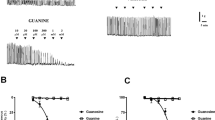Summary
The effects of 2-hydroxy and 2-methoxy oestrogens on the extraneuronal O-methylation of 3H-(−)noradrenaline were examined in progesterone-dominated, monoamine oxidase (MAO)-inhibited, rabbit uterine tissues in vitro. Both the corticosteroid- sensitive system in myometrium and the cocaine-sensitive system in endometrium were examined.
In myometrial slices preincubated with nialamide to inhibit MAO and incubated with cocaine to inhibit neuronal uptake, 3H-normetanephrine (3H-NMN) formation was inhibited in the order of potency 2-hydroxy oestrone ≥ 2-hydroxy oestradiol = 2-methoxy oestradiol ≥ 2-methoxy oestrone. In myometrial slices not exposed to cocaine and nialamide, inhibition of 3H-NMN formation by both 2-hydroxy and 2-methoxy oestradiol did not affect the formation of deaminated metabolites of 3H-(−)-noradrenaline by the alternative metabolising pathway. In endometrial slices preincubated with nialamide to inhibit MAO, only 2-hydroxy oestrogens inhibited 3H-NMN formation, but they were one to two orders of magnitude less potent in this regard than in the myometrium. The uptake of 3H-(−)-noradrenaline by MAO- and COMT-inhibited myometrial slices was inhibited by 2-hydroxy and 2-methoxy oestrogens in the order of potency 2-methoxy oestradiol ≥ 2-methoxy oestrone ≥ 2-hydroxy oestrone > 2-hydroxy oestradiol. Uptake of 3H-(−)-noradrenaline by endometrial slices was not affected by either 2-hydroxy or 2-methoxy oestrogens.
It is concluded that the O-methylatiog system for noradrenaline in myometrial tissue is more sensitive than that in endometrial tissue to the inhibitory actions of 2-hydroxy and 2-methoxy oestrogens. 2-Hydroxy oestrogens inhibit 3H-NMN formation by competing for COMT rather than noradrenaline uptake sites, since (1) they inhibited O-methylation but not uptake of 3H-noradrenaline in endometrium and (2) 2-hydroxy oestrogens were two orders of magnitude more potent against 3H-NMN formation than 3H-(−)-noradrenaline uptake in myometrium. In contrast, the ability of 2-methoxy oestrogens to inhibit myometrial but not endometrial 3H-NMN formation reflects the selective inhibitory effect of 2-methoxy oestrogens on the corticosteroid-sensitive uptake system for noradrenaline which predominates in myometrium but is minimal in endometrium. These interactions may be important in pregnancy when the local concentrations of catechol and methoxy oestrogens rise.
Similar content being viewed by others
References
Ball P, Knuppen R (1980) Catechol estrogens (2 & 4 hydroxy estrogens): chemistry, biogenesis, metabolism, occurrence and physiological significance. Acta Endocrinol Suppl (Copenh) 232:1–132
Ball P, Knuppen R, Haupt M, Breuer H (1972) Interaction between estrogens and catecholamines III. Studies on the methylation of catechol estrogens, catecholamines and other catechols by the catechol-O-methyl transferase of human liver. J Clin Endocrinol Metab 34:736–746
Barone S, Panek D, Bennet L, Stitzel RE, Head RJ (1987) The influence of oestrogen and oestrogen metabolites on the sensitivity of the isolated rabbit aorta to catecholamines. Naunyn-Schmiedeberg's Arch Pharmacol 335:513–520
Berg D, Thaler F, Kuss E (1982) Concentrations of 2-hydroxy oestrogens in human sera measured by a heterologous immunoassay with a 125I-labelled ligand. Acta Endocrinol (Copenh) 100:154–160
Berg FD, Kuss E (1987) 2-Hydroxylation and O-methylation of oestrogens by human placenta in vivo. Acta Endocrinol (Copenh) 115:272–274
Fishman J, Dixon D (1967) 2-Hydroxylation of estradiol by human placental microsomes. Biochemistry 6:1683–1687
Graefe KH, Stefano FJE, Langer SZ (1973) Preferential metabolism of (−)3H-noradrenaline through the deaminated glycol in the rat vas deferens. Biochem Pharmacol 335:513–520
Inoue K, Tice LW, Creveling CR (1980) Immunocytochemical localization of catechol-O-methyltransferase in the pregnant rat uterus. Endocrinology 107:1833–1840
Kennedy JA, de la Lande IS (1984) The effect of pregnancy on the metabolism of noradrenaline in reproductive organs of the rabbit. Naunyn-Schmiedeberg's Arch Pharmacol 326:143–147
Kennedy JA, de la Lande IS (1986) Effect of progesterone on the metabolism of noradrenaline in rabbit uterine endometrium and myometrium. Naunyn-Schmiedeberg's Arch Pharmacol 333: 368–376
Kennedy JA, de la Lande IS (1987) Characteristics of the cocaine-sensitive accumulation and O-methylation of 3H-(−)-noradrenaline by rabbit endometrium. Naunyn-Schmiedeberg's Arch Pharmacol 336:148–154
Mondschein JS, Hersey RM, Dey SK, Davis D, Weisz J (1985) Catechol estrogen formation by pig blastocysts: biochemical characterization of estrogen-2/4-hydroxylase and correlation with aromatase activity during the preimplantation period. Endocrinology 117:2339–2346
Author information
Authors and Affiliations
Rights and permissions
About this article
Cite this article
Kennedy, J.A. Effect of catechol oestrogens on extraneuronal metabolism of noradrenaline by rabbit uterine endometrium and myometrium. Naunyn-Schmiedeberg's Arch Pharmacol 343, 266–270 (1991). https://doi.org/10.1007/BF00251125
Received:
Accepted:
Issue Date:
DOI: https://doi.org/10.1007/BF00251125



